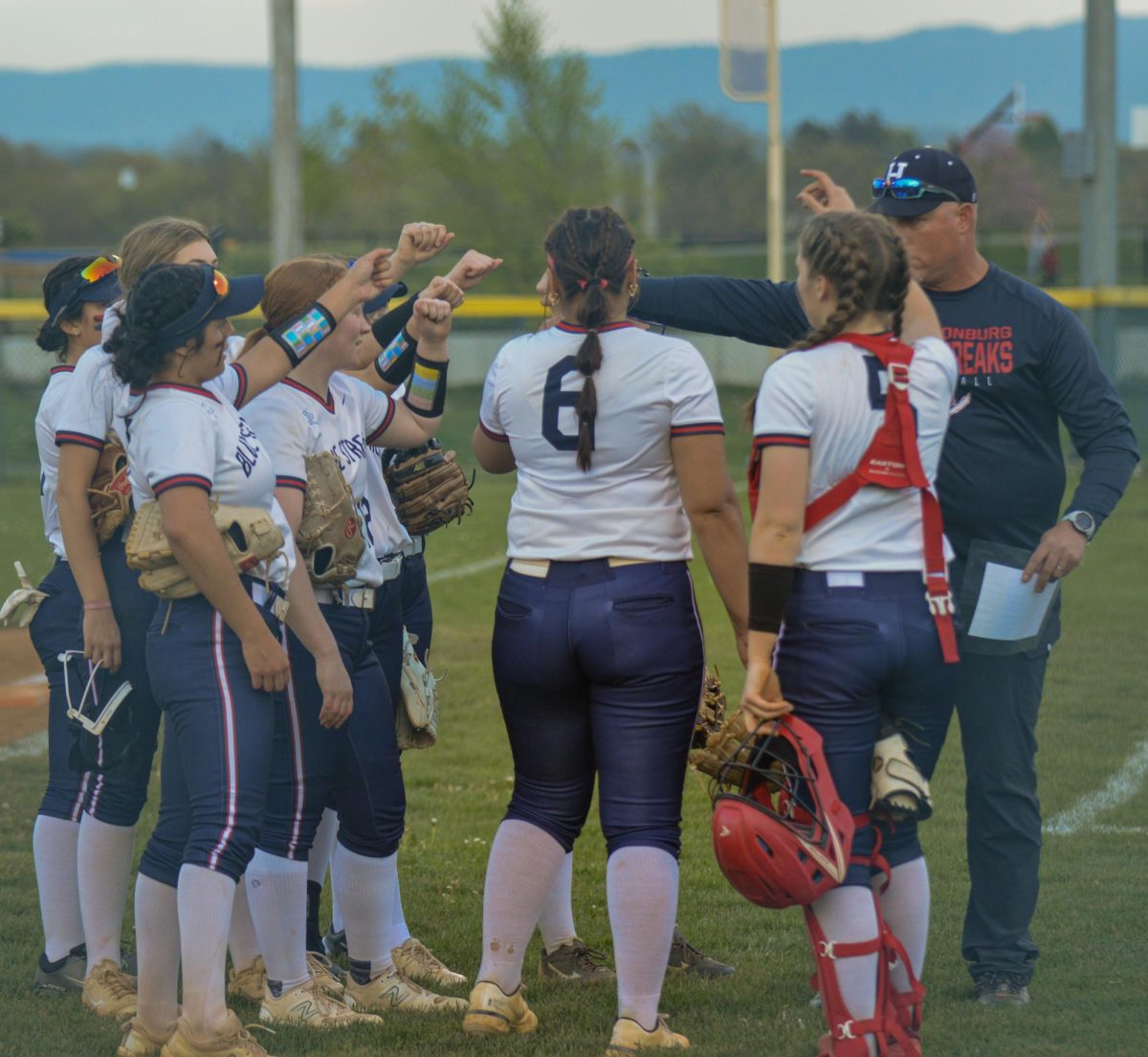Barnes lives with disorder, uses computer to communicate
Jimmy Barnes works with his nurse, Karen Zirk throughout the day. Shifflett stays with Barnes from 7 in the morning to 3 in the afternoon. “I started working with Jimmy six years ago [and] not much has changed other than him losing a little more body function,” Shifflett said. “He used to be able to do his right elbow and move it back, [but] he slowly lost that function.”
November 19, 2019
When her son was just a baby, the life of Anne McKeen was forever changed by a question asked by a team of doctors in Charlottesville, Va. McKeen was forced to make a decision regarding her son Jimmy Barnes’s health that would impact both of them for years to come.
“[The doctor] said, ‘Well, you need to make a choice. Do you want him to have a trake? That’s fine, we can do that, or you can just let him go.’ And I said, ‘We don’t know what he has, we don’t know what’s going on, let’s do the trake. Let’s do this, so we can figure it out and give him a chance,’” McKeen said.
At birth, Barnes seemed to be just like the other babies. As he continued to grow and develop, however, complications arose. After months of staying in the hospital, Barnes received a trake, short for a tracheostomy tube, and a ventilator to help him breathe.
“When he was first born, everything was fine. The scores that he got when he was a baby were good. It wasn’t until he was six months old, [that he started having problems]. He was with a babysitter, I think they were at Walmart, and somehow he had fallen forward and hyperventilated. The babysitter freaked out, which I would’ve done too,” McKeen said. “That got us over to Charlottesville for a couple days, [but] they weren’t sure what was going on. They sent us home to keep an eye on him, and then it happened again where he had problems breathing. That got us back to Charlottesville for an extended stay. We were there for four or five months and that’s when he got the trake and the ventilator. They determined at that time that his right diaphragm was paralyzed.”
Little did McKeen know, the next two decades would not get any easier. Barnes was eventually diagnosed with a disease that affects both his nervous system and muscles based on an article by the National Organization for Rare Disorders.
“His diagnosis is spinal muscular atrophy, [which is] respiratory distress,” McKeen said. “A lot of people, when they describe the condition, [describe it] as a pediatric form of [amyotrophic lateral sclerosis], [or] Lou Gehrig’s disease. People know what that is and what that does to people [and it comes with] a lot of challenges. Jimmy, he needs help with everything. He can’t physically do anything for himself. As he’s gotten bigger, transferring him from his bed to his wheelchair and back has gotten harder on his dad and I, [but] you just make it work.”
Additionally, Barnes has scoliosis, which required medical attention and surgeries to correct in previous years.
“He has scoliosis and so for a long time, starting at the age of four, he had these rods put in his back to help correct [it]. Every six months he had to go in and have those lengthened as he grew, so from the time he was four to the time he was fourteen or fifteen, he had surgery every six to nine months,” McKeen said. “His rods look good, so now we go back in five years just to double check to make sure everything’s alright. They decided to leave the rods in because they thought it would be more traumatic to take them out, but his back is fusing on its own. Before he had the surgery, it’s kind of hard to imagine, but his back had a ninety degree curve in it. You could tell sitting in a wheelchair, he was leaning way over and they were able to get [it corrected] to forty degrees, which is good because it saved his breathing [and] it allowed his lungs to continue to grow.”
Despite his conditions, Barnes, currently 20 years old, continues to show his intellectual strength regarding his academics. Barnes is currently attending HHS to complete his post-grad education after graduating from Turner Ashby High School two years ago. Students in special education programs can attend school until they’re 22 years old; therefore, Barnes has two more years before he is finished with his education.
“He walked, per se, with his class at Turner Ashby, so he does have a diploma,” McKeen said. “He has a one on one aid that is with him in class that helps him take notes [and] do any type of work because he’s not able to hold a pencil or a pen or anything like that, but he really amazes me [because] he’s able to listen to all that and as far as studying for tests, he didn’t study like maybe you or I do. I was just amazed at how he was able to recall facts and whatnot that I wasn’t even sure of, even though I had helped him study.”
Not only does Barnes enjoy going to school in order to learn new things, but he also enjoys the other students and faculty members he sees throughout the school day.
“He seems to enjoy being in the main-stream classes and being around his peers,” McKeen said. “I think he has literature and biology this year. In past years, he’s taken astronomy. Physics he had last year, he enjoyed that [because of] the group activities and the experiments they did. There was one class he was in last year, it was called Street Law. They did a lot of group projects and he really, really enjoyed that. There were a couple people in that class he formed friendships with [who would] invite him to eat lunch with them and he just loved it. He didn’t really care if he had time to eat or not cause he wanted to get up and join them in the cafeteria just to hang out.”
Along with the support from his mother, Barnes also has a personal assistant, Karen Zirk, who gets him from McKeen in the morning and stays by his side all day while at school until his mom comes to pick him back up in the afternoon.
“He can’t always tell me exactly [what he wants or needs], so I kind of have to finesse it a little bit to figure out what he is expressing. There are other things that he’s really direct about, but some things are not as direct as others, so that’s a little bit harder,” Zirk said.
In addition to Zirk, Barnes’s nurse Amber Shifflett is also by his side. Shifflett, however, is with him for a longer period of time. She works the day shift, so she is with Barnes from 7 a.m. until 3 p.m.
“I started working with Jimmy six years ago [and] not much has changed other than him losing a little more body function,” Shifflett said. “He used to be able to do his right elbow and move it back, [but] he slowly lost that function.”
While Zirk assists Barnes in his academics, Shifflett takes on the medical side, which requires constant attention throughout the day, especially to his gastrostomy tube.
“The only challenge that I really have is with his trake and G-tube because you always have to watch and make sure everything is great to make sure he’s fine. [The trake] pushes air into the lungs, so they can inflate and deflate and help him breathe [since his] diaphragm is paralyzed,” Shifflett said.
At home, especially in during the night when Shifflett is not there to assist the family with medical needs, Barnes must be close to McKeen due to the fact that she needs to be able to hear any warning alarms in regards to the well-being of her son.
“The biggest thing is we always have to be in 15 feet of Jimmy. Not so much we have to be hands on doing something, but you have to be close enough that you can hear an alarm. The alarm that you’ll hear is not so much [that] his trake has come out, but the circuit from his ventilator [is interrupted and] he’s not breathing, so you need to be able to act quickly and fix that issue,” McKeen said. “In August, his alarm went off and it was a mucus plug in his trake. We couldn’t move it, we couldn’t suction it out, so we had to do an emergency trake change at 2:30 in the morning and it [was] kind of scary. What about people that can’t do a trake change? What about people that don’t feel comfortable [helping Barnes]? Well, by the time you call 911, by the time they get there, it’s going to be too late, so you have to be able to do it. Fortunately, when he was a baby at Charlottesville, the respiratory therapist and the nurses were really good at teaching us how to do all of his care and training us how to respond in an emergency. I can’t imagine that they would let any parent leave without being able to do that kind of stuff. I’m kind of surprised [about] the stories I hear about parents that don’t know how.”
Although some children with SMA are still able to talk, Barnes cannot.
“Some of the kids with the same disability can still talk and everything just fine. Jimmy is different, he has to use a communication device,” Shifflett said.
Barnes uses a computer now, but prior to obtaining it, communicating with people he wasn’t around daily was very challenging for Barnes.
“I could understand him and his family could understand him, but for other people outside of that, it was a little more difficult. We knew at some point he was going to have to have a way to communicate,” McKeen said.
While participating in speech therapy at James Madison University when he was around three or four years old, Barnes had an opportunity that changed his life where he received a computer that talks for him based on his selections.
“[JMU was] able to bring in a representative for the computer that was able to try him out on a variety of different platforms. We knew at that point of time he was able to vocalize a little bit more [because] at that time, he still had the trake, but it didn’t have a cuff on it, so air was able to still get passed his vocal cords, [which allowed him to speak],” McKeen said.
Now that he has the cuff on his trake, air can no longer get to his vocal cords, which is why the computer is necessary. Since Barnes’s physical abilities are limited, the device uses the body part he moves best, his left shoulder.
“The shoulder is the one part he does the best, so he uses it to click. The first click scrolls up and down the rows and then he can click it again to go across the row. He clicks [one last time] to [select the symbol] he needs to use,” Shifflett said.
Shortly after he received his computer, Barnes was expected to speak in complete sentences; however, according to McKeen, that’s an expectation that isn’t needed.
“When he was younger, the push was always ‘Well, Jimmy you need to speak in complete sentences.’ Yeah, that’s great, but it takes him time. Now, he’ll give you one or two words and if that’s not enough, if you still don’t understand what he’s trying to say, you can ask him for more and then he’ll try to give you more to explain [the point] he’s trying to get across. The complete sentences thing, for a long time, he’d just shut down. If he thinks something is stupid, he’s just not going to do it,” McKeen said. “When you’re writing, yes it’s important to use complete sentences, but [in terms of] communication back and forth, sometimes you can get your point across without a complete sentence.”
Even though Barnes’ eyes are not negatively impacted by the communication device, he still does vision exercises with Zirk while his class is in the gym with special education Walt Williamson.
“In his gym class, a lot of times he observes. What we do is split the time between watching and participating in what the class is doing and [practicing] his eye gaze, which is a technology he uses to play on a computer,” Zirk said.
In addition to using his computer for communication purposes, Barnes also enjoys playing games and watching Youtube on it as well.
“[My favorite things to do with the computer is to play] fish [or watch] Donkey Kong, Plants vs. Zombies, and Power Rangers,” Barnes said.
Since it takes Barnes a while to select the symbols and ultimately say what he wants to say, he began using clicking as a quicker method of communication.
“He started clicking as a way to acknowledge people. As people are around him and gain a little bit of understanding of that, it helps. If he is somewhere he doesn’t have access to his computer, which isn’t very often, [or] if you ask him a question and can’t see his face, [or] sometimes on the telephone when people are talking to him, they’ll ask him a question and it will be a yes or no, click once for yes or two for no. If I ask him a question for a number, he will click and so I’ll count the number of clicks. He does things like that to speed up conversation,” McKeen said. “Sometimes the clicking is just to get your attention. If he’s doing something, and for some reason he can’t hit the switch that he uses on his shoulder, he’ll do rapid fire clicking to get your attention, [so you’ll fix the problem].”
Due to the rare disorder that Barnes lives with every day, McKeen looks for support from others that are impacted by the disease on social media.
“It’s very rare. There’s about 80 cases [of his disorder worldwide],” McKeen said. “There’s a support group on Facebook that I’m a member of [and] I think the oldest person just passed away a couple months ago. He was 29.”
Her family, as well as Medicaid, have both supported McKeen and Barnes financially after she divorced from Barnes’s biological father about eight years ago.
“I quit my full time job to stay at home and provide care if he needed it if we didn’t have nursing at hand and just to take care of everything household related,” McKeen said. “He is qualified for Medicaid [under] a tech waiver because he is on a trake and a ventilator. They pay for all the nursing, equipment, supplies, all that kind of stuff, so that part was taken care of. We had some help from family, too [and] they helped to provide some support through the lean times.”
McKeen eventually remarried, which eventually helped ease her stress and keep both her and her son happy.
“My biggest fear when I got divorced was here I am, a single mom, a stay at home mom of someone with a disability, what are the chances that I’m going to find someone that is going to want to take this on? But I did find somebody and he’s really stepped up to the plate [and] considers Jimmy his own. They have a great relationship,” McKeen said.
As Barnes continues to get older, his mother doesn’t know what the future may hold for the family overall.
“[If someone has] an intellectual disability, there are programs that they can go into, but Jimmy doesn’t have that diagnosis, so we’re not really sure [what we’ll do when he’s done with school],” McKeen said. “We don’t want him to just stay at home all the time because he likes to get out and do things, so we have a couple ideas. Maybe we could pair him up with a JMU student that maybe he meets somewhere in the community twice a week. I don’t really know yet.”
Within the past two decades, Barnes has accomplished various goals that McKeen didn’t think would happen when he was a child.
“You never look too far ahead, but he’s done a number of things that I had hoped he would do,” McKeen said. “To be honest, when he was younger and we finally figured out what his diagnosis was, I didn’t think he would still be alive. I dreamed when he was younger [about him graduating] from high school, if we could do that, that would be great and now here we are and he’s done that.”
For Zirk, Shifflett and McKeen, Barnes holds a special place in their hearts for a number of reasons.
“I just think Jimmy is amazing. He just has a great smile and he’s got a sense of humor that you wouldn’t believe. He’s a jokester, he really is,” Zirk said.
The love that many people have for her son is not surprising to McKeen since Barnes’s personality is one of a kind. Additionally, she also believes his mindset alongside his personality will set Barnes up for future accomplishments.
“I feel that something will work out for him. He’s good at making friends, people seem to like to be around him and he has a great personality, so I hope something comes out of it and works out for him,” McKeen said.











